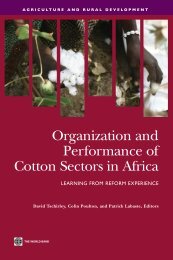Constraints to smallholders participation in Cassava value ... - aaacp
Constraints to smallholders participation in Cassava value ... - aaacp
Constraints to smallholders participation in Cassava value ... - aaacp
Create successful ePaper yourself
Turn your PDF publications into a flip-book with our unique Google optimized e-Paper software.
economic asset thresholds, will <strong>in</strong>fluence household propensity <strong>to</strong> adopt cassava production forcommercial purposes. An hypothesis that emerged is that non-growers were <strong>in</strong>tegrated <strong>to</strong> a greaterdegree – either by choice or compulsion – <strong>in</strong> the cash economy, for example a lower level of maizeself-sufficiency, hav<strong>in</strong>g greater reliance on employment and hav<strong>in</strong>g more outstand<strong>in</strong>g credit – andparticipate <strong>to</strong> a lesser degree <strong>in</strong> community and agricultural market<strong>in</strong>g organisations. A potentialpredisposition aga<strong>in</strong>st farm<strong>in</strong>g among some rural households is possible, therefore, and emphasisesthat the expected supply response <strong>to</strong> <strong>in</strong>terventions and <strong>in</strong>itiatives is likely <strong>to</strong> be heterogeneous. It isthe target<strong>in</strong>g of <strong>in</strong>terventions that is likely <strong>to</strong> <strong>in</strong>fluence the outcomes of development <strong>in</strong>itiatives <strong>in</strong>the cassava sec<strong>to</strong>r.Inferences that can be reliably drawn are that significant <strong>in</strong>vestment is needed <strong>in</strong> capacity build<strong>in</strong>gamong producers <strong>in</strong> order <strong>to</strong> respond <strong>to</strong> favourable market signals. Basic extension services areneeded <strong>to</strong> address the lack of plant<strong>in</strong>g materials of the appropriate varieties, and the limited skills <strong>in</strong>new production process<strong>in</strong>g practices. Support<strong>in</strong>g <strong>in</strong>vestments through <strong>in</strong>novative f<strong>in</strong>ancialmechanisms are needed for new technologies and services for a large expansion of farm scale <strong>to</strong>meet projected demand. Concentration of supply through local bulk<strong>in</strong>g is essential <strong>to</strong> reducetransaction and transport costs faced by buyers and external logistics players. Local producer grouporganisation is one effective means which will also require development and extension ofappropriate organisational models, as well as <strong>in</strong>vestment <strong>in</strong> group organisation and managementskills. Local group organisation is a common phenomenon, but once aga<strong>in</strong> there are real challenges<strong>in</strong> creat<strong>in</strong>g an efficient and susta<strong>in</strong>able collective enterprise sec<strong>to</strong>r. However, strengthen<strong>in</strong>g exist<strong>in</strong>gcommunity groups is considered preferable <strong>to</strong> form<strong>in</strong>g new groups with external or even publicsec<strong>to</strong>r support. Fundamental supply cha<strong>in</strong> management practices are almost entirely absent andnew bus<strong>in</strong>ess models will be necessary for efficient and effective large scale cassava production anddistribution. Private sec<strong>to</strong>r leadership <strong>in</strong> respect of sec<strong>to</strong>r development is probably necessary, andthe <strong>in</strong>volvement of smaller private sec<strong>to</strong>r players such as rural traders and transporters may prove<strong>to</strong> be vital supply cha<strong>in</strong> l<strong>in</strong>ks.1.1 A brief literature reviewAmong the arable possibilities, cassava has considerable potential <strong>in</strong> Zambia as a crop fordiversify<strong>in</strong>g farm production, <strong>in</strong>creas<strong>in</strong>g rural food security at the producer household level, as an<strong>in</strong>put <strong>in</strong><strong>to</strong> the processed food markets for human consumption, and as an <strong>in</strong>put for domestic<strong>in</strong>dustrial development and export markets. <strong>Cassava</strong> sec<strong>to</strong>r development is consistent with thereport of a recent study by the World Bank on the prospects for commercial agriculture <strong>in</strong> certa<strong>in</strong>regions of Africa:‘Zambia … has considerable agricultural potential, but this potential rema<strong>in</strong>s largelyunexploited... Of the land considered arable, nearly 420,000 square kilometers are classifiedas hav<strong>in</strong>g medium-<strong>to</strong>-high potential for agriculture, but only about 15 percent of themedium-<strong>to</strong>-high–potential arable land is currently be<strong>in</strong>g utilized... The population density <strong>in</strong>most of the productive regions is still very low, rang<strong>in</strong>g from 1 <strong>to</strong> 11 people per squarekilometer. Ra<strong>in</strong>fall ranges between 800 and 1,400 millimeters annually, <strong>in</strong>creas<strong>in</strong>g fromsouth <strong>to</strong> north. The northern regions receive ample ra<strong>in</strong>fall and are quite sparsely populated.The southern regions are much dryer and suffer from frequent drought... On the plateausaround Lusaka, Liv<strong>in</strong>gs<strong>to</strong>ne, Kabwe, and Chipata, soils are generally fertile, and ra<strong>in</strong>fall issufficient <strong>to</strong> support production of a wide range of crops. Further north, the soils are5
















